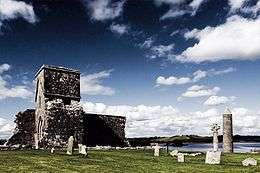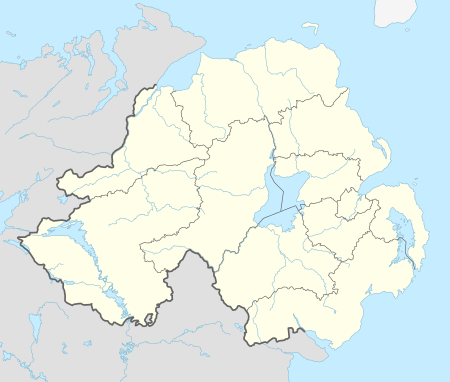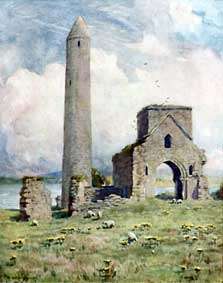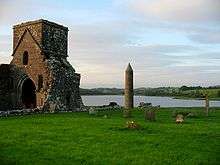Devenish Island
Devenish or Devinish[1] (from Irish: Daimhinis, meaning "ox island") is an island in Lower Lough Erne, County Fermanagh, Northern Ireland. Aligned roughly north–south, it is about one and a quarter miles long and two-thirds of a mile wide. The main place to catch a ferry to the island is at Trory Point, just outside Enniskillen. Devenish Island is owned by the Kilravock Christian Trust.[2]
 Monastic site on Devenish Island | |
 Devenish or Devinish Island | |
| Geography | |
|---|---|
| Location | Lower Lough Erne |
| Coordinates | 54°22′20.31″N 7°39′27.51″W |
| Area | 0.498 km2 (0.192 sq mi) |
| Length | 2 km (1.2 mi) |
| Width | 1.1 km (0.68 mi) |
| Highest elevation | 64.3 m (211 ft) |
| Highest point | Sour Hill |
| Administration | |
Northern Ireland (United Kingdom) | |
Features
Devenish contains one of the finest monastic sites in Northern Ireland. A round tower thought to date from the twelfth century is situated on the island, as are the walls of the Oratory of Saint Molaise who established the monastery in the 6th century,[3] on a pilgrim route to Croagh Patrick in County Mayo.
It became a centre of scholarship and, although raided by Vikings in 837 and burned in 1157, it later flourished as the site of the parish church and St Mary's Augustinian Priory.

There are extensive low earthworks on the hillside, but the earliest buildings are St Molaise's House (a very small church) and the fine round tower close by, both with accomplished Romanesque decoration of the 12th century. The round tower is some 30 metres (100 ft) tall and can be climbed using internal ladders. It features a sculptured Romanesque cornice of heads and ornament under the conical stone roof.[3]
Nearby is a cross carved with spiral patterns and human heads. There are also several cross-slabs, one with an interlace design and a mediaeval carved cross. Near the round tower, the foundations of another tower were found, which the present tower probably superseded.[4]
The smallest of the three churches (Mo-Laisse's House, named after the founder of the monastery) dates from the late 12th or early 13th century. It has narrow antae with bases carved with classical motifs. Only the lower parts of the walls and some of the roofstones survive.[4]
Teampull Mór, the lower church, dates from the early 13th century with a beautifully moulded south window. It was extended to the east in about 1300, and later additions include a residential wing to the north and the Maguire Chapel to the south, with 17th-century heraldic slabs.

On the hilltop sits St Mary's Augustinian Priory which is of the mid-15th century and early 16th century, with church, tower and small north cloister. The priory has an intricately carved mid-15th-century high cross in its graveyard.[3] The Devenish cross dates from the 15th century and is gothic in style. It is thought to have been carved by Matthew O’Dubegan, who also carved the sacristy doorway. The cross has decorative carvings and motifs, including a depiction of the crucifixtion on the upper part of the shaft.
There are several hundred loose architectural fragments on the site and among them are over 40 stones from an otherwise lost, richly-decorated Romanesque church. Some of the many loose stones are displayed and set in their historical context in the small visitor centre.
The monastic remains including churches, round tower etc. are State Care Historic Monuments in the townland of Devenish, in Fermanagh District Council area, at grid ref: area of H224 469.[5] The monastic site (area surrounding the state care monument, grid ref: H224 469) and the rath (grid ref: H2215 4768) are Scheduled Historic Monuments.[6]
See also
References
- "Daimhinis/Devinish". Logainm.ie. Retrieved 13 August 2017.
- "Kilravock Castle (pronounced 'Kil-rawk') dates from 1460". Kilravockcastle.com. Retrieved 13 August 2017.
- O'Neill, B (ed) (2002). Irish Cathedrals, Churches and Abbeys. London: Caxton Editions. p. 63.CS1 maint: extra text: authors list (link)
- Weir, A (1980). Early Ireland. A Field Guide. Belfast: Blackstaff Press. p. 144. ISBN 0-85640-212-5.
- "State Care Historic Monuments" (PDF). Environment and Heritage Service. March 2007. Archived from the original (PDF) on 22 July 2012. Retrieved 3 December 2007.
- "Scheduled Historic Monuments" (PDF). Environment and Heritage Service. March 2007. Archived from the original (PDF) on 5 November 2008. Retrieved 3 December 2007.
- Curtis, Liz (2004). "Ancient Island Sites on Lough Erne". Culture Northern Ireland. Archived from the original on 24 February 2012. Retrieved 19 March 2009.
- "Devenish Island". www.enniskillen.com. Archived from the original on 24 December 2008. Retrieved 19 March 2009.
- "Devenish Monastic Site". Northern Ireland Environment Agency. Archived from the original on 24 December 2012. Retrieved 19 March 2009.
Further reading
- Donnelly, Colm J. Living Places. Institute of Irish Studies. ISBN 978-0-85389-475-9.
External links
| Wikimedia Commons has media related to Devenish Island. |
- Virtual tour of Devenish Island Monastic Site – Virtual Visit Northern Ireland